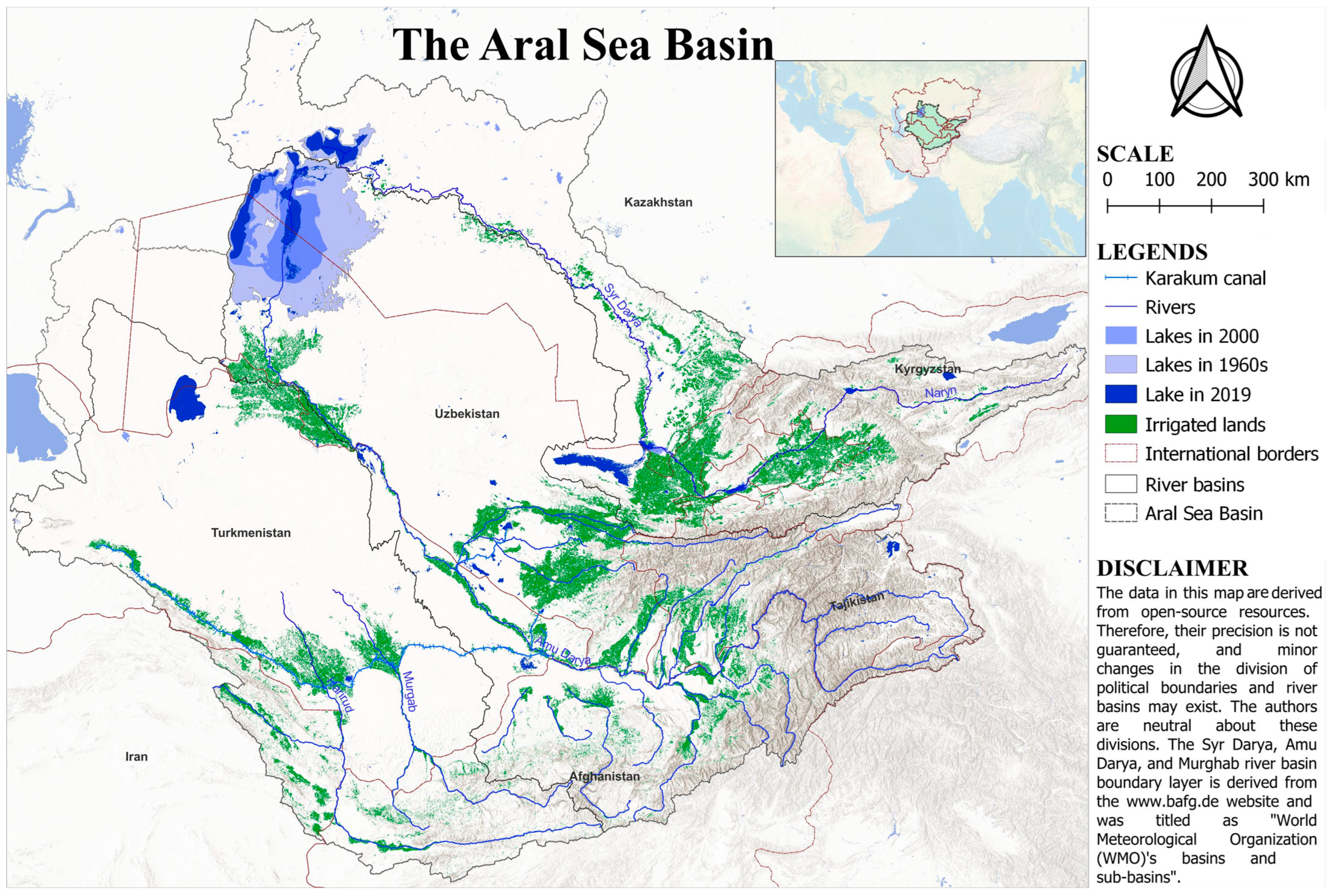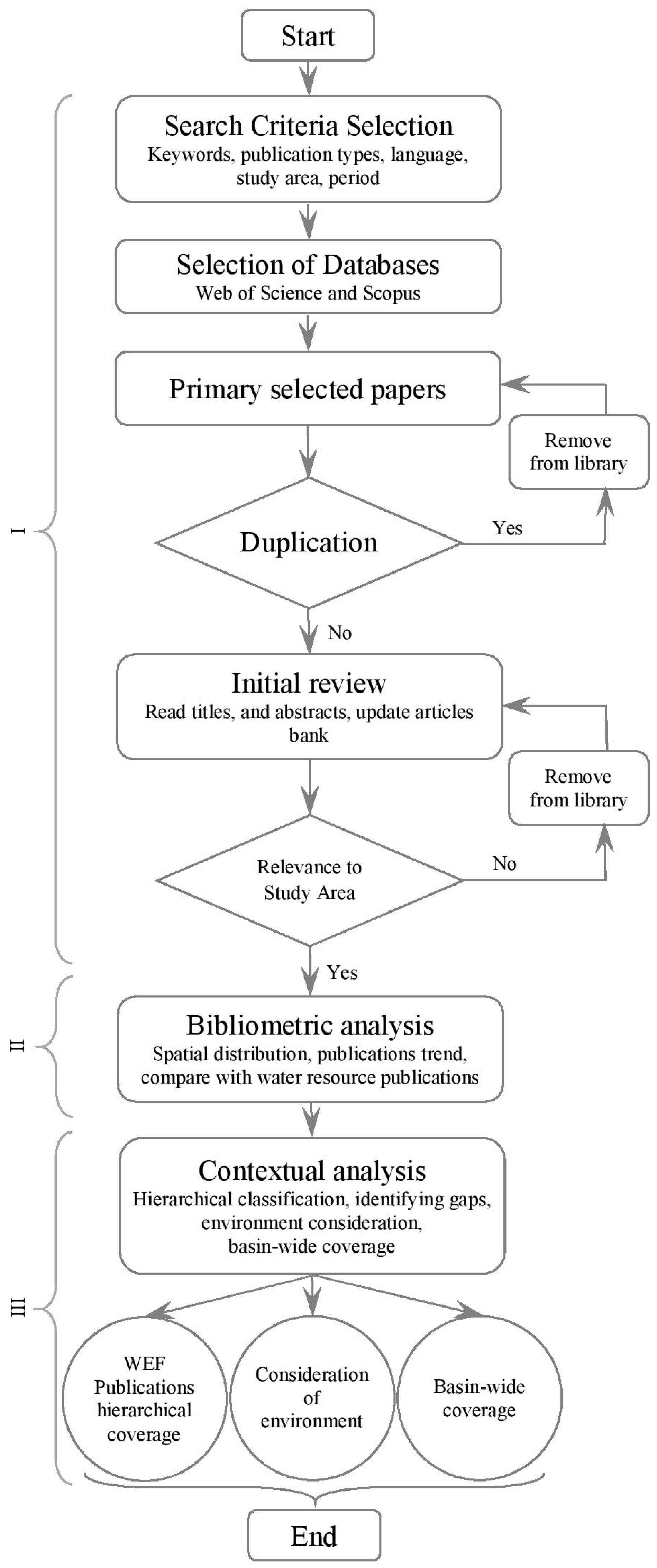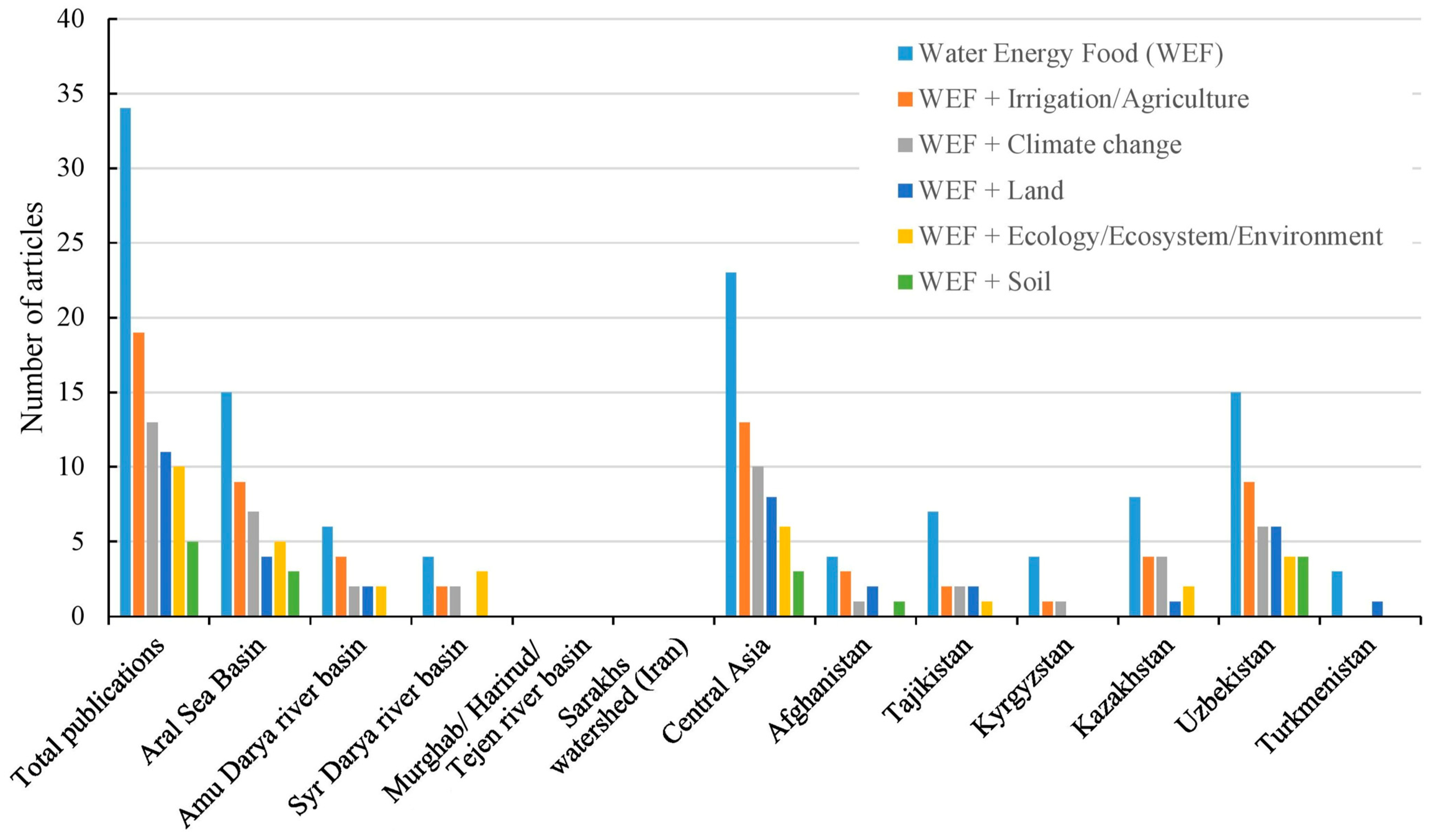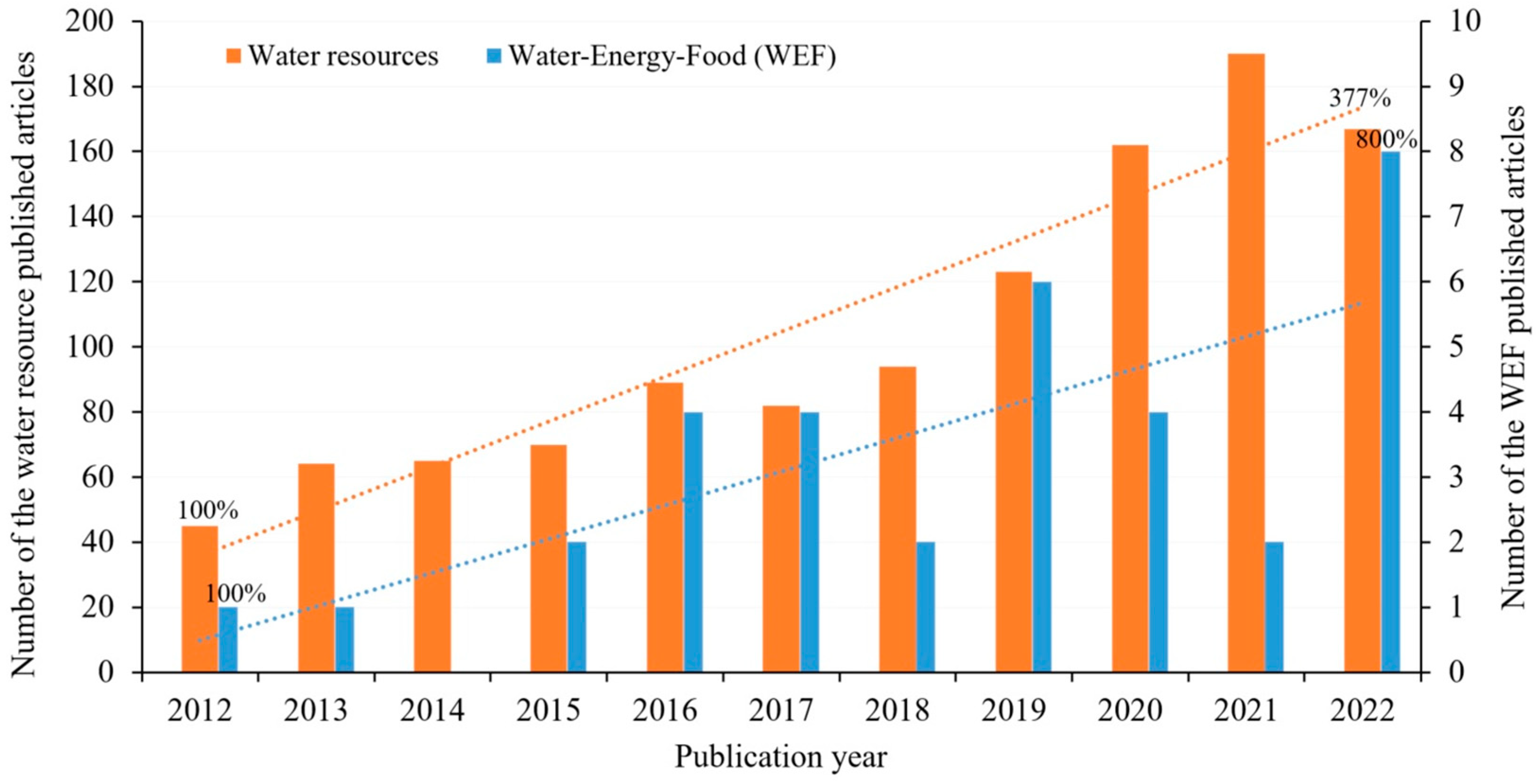Consideration of the Environment in Water-Energy-Food Nexus Research in the Aral Sea Basin
Abstract
1. Introduction
2. Materials and Methods
2.1. The Aral Sea Basin
| Countries | Area Share of the Country in the Basin (%) | Extent of Share in the Basin (%) | Mean Annual Water Resources 1 (%) | Water Withdrawal from the Basin 2 (%) | Irrigated Area Share in the Basin 3 (%) | Hydropower Production Share in the Basin 4 (%) | Population Share in the Basin 5 (%) | GDP per Capita 6 (USD) |
|---|---|---|---|---|---|---|---|---|
| Afghanistan | 37.40 | 13.70 | 16.64 | 6.95 2a | 11.97 | 0.82 4a | 17.34 | 368.8 |
| Iran | 2.60 | 2.00 | 0.42 1a | 2.09 2a | 4.56 | 0.11 4b | 6.71 | 4091.2 |
| Kazakhstan | 12.70 | 19.50 | 1.92 | 1.49 | 10.15 | 1.32 | 5.60 | 10373.8 |
| Kyrgyzstan | 59.20 | 6.70 | 23.07 | 0.32 | 4.39 | 15.84 | 4.88 | 1276.7 |
| Tajikistan | 99.00 | 7.98 | 47.86 | 8.88 | 8.22 | 68.88 | 12.92 | 897.0 |
| Turkmenistan | 94.60 | 26.10 | 1.22 | 16.40 | 18.75 | 0.17 | 7.84 | 7344.6 |
| Uzbekistan | 95.00 | 24.02 | 8.87 | 36.03 | 41.95 | 12.86 | 44.71 | 1983.1 |
2.2. Methods
3. Results and Discussions
3.1. The WEF Nexus Publication in the ASB
3.2. Consideration of the Environment in the WEF Analyses in the ASB
4. Conclusions
Author Contributions
Funding
Data Availability Statement
Conflicts of Interest
References
- Purwanto, A.; Sušnik, J.; Suryadi, F.X.; de Fraiture, C. Water-Energy-Food Nexus: Critical Review, Practical Applications, and Prospects for Future Research. Sustainability 2021, 13, 1919. [Google Scholar] [CrossRef]
- Biggs, E.M.; Bruce, E.; Boruff, B.; Duncan, J.M.A.; Horsley, J.; Pauli, N.; McNeill, K.; Neef, A.; Van Ogtrop, F.; Curnow, J.; et al. Sustainable development and the water–energy–food nexus: A perspective on livelihoods. Environ. Sci. Policy 2015, 54, 389–397. [Google Scholar] [CrossRef]
- WEF. Water Security: The Water-Food-Energy-Climate Nexus; Island Press: Washington, DC, USA, 2011. [Google Scholar]
- Terrapon-Pfaff, J.; Ortiz, W.; Dienst, C.; Grone, M.C. Energising the WEF nexus to enhance sustainable development at local level. J. Environ. Manag. 2018, 223, 409–416. [Google Scholar] [CrossRef]
- Abulibdeh, A.; Zaidan, E. Managing the water-energy-food nexus on an integrated geographical scale. Environ. Dev. 2020, 33, 100498. [Google Scholar] [CrossRef]
- Jalilov, S.M.; Amer, S.A.; Ward, F.A. Managing the water-energy-food nexus: Opportunities in Central Asia. J. Hydrol. 2018, 557, 407–425. [Google Scholar] [CrossRef]
- Jalilov, S.M.; Keskinen, M.; Varis, O.; Amer, S.; Ward, F.A. Managing the water-energy-food nexus: Gains and losses from new water development in Amu Darya River Basin. J. Hydrol. 2016, 539, 648–661. [Google Scholar] [CrossRef]
- Saidmamatov, O.; Rudenko, I.; Pfister, S.; Koziel, J. Water–Energy–Food Nexus Framework for Promoting Regional Integration in Central Asia. Water 2020, 12, 1896. [Google Scholar] [CrossRef]
- Hamidov, A.; Daedlow, K.; Webber, H.; Hussein, H.; Abdurahmanov, I.; Dolidudko, A.; Seerat, A.Y.; Solieva, U.; Woldeyohanes, T.; Helming, K. Operationalizing water-energy-food nexus research for sustainable development in social-ecological systems: An interdisciplinary learning case in Central Asia. Ecol. Soc. 2022, 27. [Google Scholar] [CrossRef]
- Jalilov, S.M.; Amer, S.A.; Ward, F.A. Water, Food, and Energy Security: An Elusive Search for Balance in Central Asia. Water Resour. Manag. 2013, 27, 3959–3979. [Google Scholar] [CrossRef]
- Hao, L.; Wang, P.; Yu, J.; Ruan, H. An integrative analytical framework of water-energy-food security for sustainable development at the country scale: A case study of five Central Asian countries. J. Hydrol. 2022, 607, 127530. [Google Scholar] [CrossRef]
- Karatayev, M.; Rivotti, P.; Mourão, Z.S.; Konadu, D.D.; Shah, N.; Clarke, M. The Water-Energy-Food Nexus in Kazakhstan: Challenges and Opportunities; Elsevier Ltd.: Amsterdam, The Netherlands, 2017. [Google Scholar]
- Graham, N.A.; Pueppke, S.G.; Uderbayev, T. The current status and future of Central Asia’s fish and fisheries: Confronting a wicked problem. Water 2017, 9, 701. [Google Scholar] [CrossRef]
- Shi, H.; Luo, G.; Zheng, H.; Chen, C.; Hellwich, O.; Bai, J.; Liu, T.; Liu, S.; Xue, J.; Cai, P.; et al. A novel causal structure-based framework for comparing a basin-wide water-energy-food-ecology nexus applied to the data-limited Amu Darya and Syr Darya river basins. Hydrol. Earth Syst. Sci. 2021, 25, 901–925. [Google Scholar] [CrossRef]
- Qin, J.; Duan, W.; Chen, Y.; Dukhovny, V.A.; Sorokin, D.; Li, Y.; Wang, X. Comprehensive evaluation and sustainable development of water–energy–food–ecology systems in Central Asia. Renew. Sustain. Energy Rev. 2022, 157, 112061. [Google Scholar] [CrossRef]
- Zhang, Y.F.; Li, Y.P.; Huang, G.H.; Ma, Y. A copula-based stochastic fractional programming method for optimizing water-food-energy nexus system under uncertainty in the Aral Sea basin. J. Clean. Prod. 2021, 292, 126037. [Google Scholar] [CrossRef]
- Loodin, N. Aral Sea: An environmental disaster in twentieth century in Central Asia. Model. Earth Syst. Environ. 2020, 6, 2495–2503. [Google Scholar] [CrossRef]
- Aladin, N.V.; Plotnikov, I.S.; Micklin, P.; Ballatore, T. Aral Sea: Water level, salinity and long-term changes in biological communities of an endangered ecosystem-past, present and future. Nat. Resour. Environ. Issues 2009, 15, 177–183. [Google Scholar]
- Abuduwaili, J.; Liu, D.; Wu, G. Saline dust storms and their ecological impacts in arid regions: Saline dust storms and their ecological impacts in arid regions. J. Arid. Land 2010, 2, 144–150. [Google Scholar] [CrossRef]
- Massakbayeva, A.; Abuduwaili, J.; Bissenbayeva, S.; Issina, B.; Smanov, Z. Water balance of the Small Aral Sea. Environ. Earth Sci. 2020, 79, 75. [Google Scholar] [CrossRef]
- Shibuo, Y.; Jarsjoe, J.; Destouni, G. Hydrological responses to climate change and irrigation in the Aral Sea drainage basin. Geophys. Res. Lett. 2007, 34. [Google Scholar] [CrossRef]
- Shibuo, Y. Modelling Water and Solute flows at Land-Sea and Land-Atmosphere Interfaces under Data Limitations, in Dissertations from the Department of Physical Geography and Quaternary Geology. Ph.D. Thesis, Institutionen för Naturgeografi och Kvartärgeologi, Stockholm, Sweden, 2007; p. 130. [Google Scholar]
- Xenarios, S.; Schmidt-Vogt, D.; Qadir, M.; Janusz-Pawletta, B.; Abdullaev, I. The Aral Sea Basin: Water for Sustainable Development in Central Asia; Routledge: Oxfordshire, UK, 2019; p. 253. [Google Scholar]
- Pohl, B.; Kramer, A.; Hull, W.; Blumstein, S.; Abdullaev, I.; Kazbekov, J.; Reznikova, T.; Strikeleva, E.; Interwies, E.; Görlitz, S. Rethinking Water in Central Asia; adelphi and CAREC: Berlin, Germany, 2017; p. 131. Available online: https://adelphi.de/en/publications/rethinking-water-in-central-asia (accessed on 5 February 2024).
- Assubayeva, A.; Xenarios, S.; Li, A.; Fazli, S. Assessing water security in Central Asia through a Delphi method and a clustering analysis. Front. Environ. Sci. 2022, 10, 970633. [Google Scholar] [CrossRef]
- Guillaume, J.H.A.; Kummu, M.; Eisner, S.; Varis, O. Transferable principles for managing the nexus: Lessons from historical global water modelling of central Asia. Water 2015, 7, 4200–4231. [Google Scholar] [CrossRef]
- Micklin, P. Introduction to the Aral Sea and Its Region. In The Aral Sea: The Devastation and Partial Rehabilitation of a Great Lake; Micklin, P., Aladin, N.V., Plotnikov, I., Eds.; Springer: Berlin/Heidelberg, Germany, 2014; pp. 15–40. [Google Scholar]
- Micklin, P. The Aral Sea Disaster. Annu. Rev. Earth Planet. Sci. 2007, 35, 47–72. [Google Scholar] [CrossRef]
- Burr, G.; Kuzmin, Y.; Krivonogov, S.; Gusskov, S.; Cruz, R. A history of the modern Aral Sea (Central Asia) since the Late Pleistocene. Quat. Sci. Rev. 2019, 206, 141–149. [Google Scholar] [CrossRef]
- Pradhan, R. Natural Resources and Violent Conflicts: Water and Energy in Kyrgyzstan. J. Asian Afr. Stud. 2022, 57, 650–666. [Google Scholar] [CrossRef]
- Hamidov, A.; Helming, K.; Balla, D. Impact of agricultural land use in Central Asia: A review. Agron. Sustain. Dev. 2016, 36, 6. [Google Scholar] [CrossRef]
- Bank, W. Agriculture, Forestry, and Fishing, Value Added (% of GDP). Available online: https://data.worldbank.org/indicator/NV.AGR.TOTL.ZS (accessed on 14 March 2023).
- Narbayep, M.; Pavlova, V. The Aral Sea, Central Asian Countries and Climate Change in the 21st Century; United Nations ESCAP, IDD: Bangkok, Thailand, 2022; Available online: https://www.unescap.org/kp/2022/aral-sea-central-asian-countries-and-climate-change-21st-century (accessed on 21 February 2024).
- Nations, U. Second Assesment of Transboundary Rivers, Lakes and Groundwaters, 1st ed.; Economic commission for Europe: Convention on the Protection and Use of Transboundary Watercourses and International Lakes; United Nations Publications: New York, NY, USA; Geneva, Switzerland, 2011. [Google Scholar]
- Wang, X.; Chen, Y.; Li, Z.; Fang, G.; Wang, F.; Liu, H. The impact of climate change and human activities on the Aral Sea Basin over the past 50 years. Atmos. Res. 2020, 245, 105125. [Google Scholar] [CrossRef]
- Potapov, P.; Turubanova, S.; Hansen, M.C.; Tyukavina, A.; Zalles, V.; Khan, A.; Song, X.-P.; Pickens, A.; Shen, Q.; Cortez, J. Global maps of cropland extent and change show accelerated cropland expansion in the twenty-first century. Nat. Food 2022, 3, 19–28. [Google Scholar] [CrossRef] [PubMed]
- CAwaterinfo. Water Resources of the Aral Sea Basin: Groundwater, Waste and Drainage Water, Dams and Hydropower. Available online: http://www.cawater-info.net/index_e.htm (accessed on 21 February 2024).
- Rose, A.; McKee, J.; Sims, K.; Bright, E.; Reith, A.; Urban, M. LandScan Global 2020; Oak Ridge National Laboratory: Oak Ridge, TN, USA, 2021.
- Bank, W. GDP per Capita. World Development Indicators. Available online: https://data.worldbank.org/indicator/NY.GDP.PCAP.CD (accessed on 13 February 2023).
- Kamil, I. Afghanistan, the Amu Darya Basin and Regional Treaties. Chin. J. Environ. Law 2021, 5, 37–62. [Google Scholar] [CrossRef]
- Horsman, S. Afghanistan and transboundary water management on the Amu Darya: A political history. Cent. Asian Waters-Part 2008, 2, 63–74. [Google Scholar]
- Shroder, J.F.; Ahmadzai, S.J. Transboundary Water Resources in Afghanistan: Climate Change and Land-Use Implications; Elsevier: Amsterdam, The Netherlands, 2016; p. 546. [Google Scholar]
- Loodin, N.; Warner, J. A Review of Hydro-Hegemonic Dynamics on the Transboundary Harirud River Basin: 2001–Present. Water 2022, 14, 3442. [Google Scholar] [CrossRef]
- Mohapatra, N.K. Geopolitics of water securitisation in Central Asia. GeoJournal 2022, 88, 897–916. [Google Scholar] [CrossRef]
- der Beek, T.A.; Voß, F.; Flörke, M. Modelling the impact of Global Change on the hydrological system of the Aral Sea basin. Phys. Chem. Earth Parts A/B/C 2011, 36, 684–695. [Google Scholar] [CrossRef]
- Soliev, I.; Wegerich, K.; Kazbekov, J. The costs of benefit sharing: Historical and institutional analysis of shared water development in the Ferghana Valley, the Syr Darya Basin. Water 2015, 7, 2728–2752. [Google Scholar] [CrossRef]
- Koulouri, A.; Mouraviev, N. Governance of the water-energy-food nexus: A relational equity approach. In Policy and Governance in the Water-Energy-Food Nexus: A Relational Equity Approach; Taylor and Francis: Abingdon, UK, 2019; pp. 11–30. [Google Scholar]
- Martius, C. Let there be science separating environmental misperceptions from reality in the aral sea basin. In Environmental Crises in Central Asia: From Steppes to Seas, from Deserts to Glaciers; Taylor and Francis: Abingdon, UK, 2016; pp. 67–77. [Google Scholar]
- Hamidov, A.; Kasymov, U.; Djumaboev, K.; Paul, C. Rebound Effects in Irrigated Agriculture in Uzbekistan: A Stakeholder-Based Assessment. Sustainability 2022, 14, 8375. [Google Scholar] [CrossRef]
- Khamidov, M.; Ishchanov, J.; Hamidov, A.; Donmez, C.; Djumaboev, K. Assessment of Soil Salinity Changes under the Climate Change in the Khorezm Region, Uzbekistan. Int. J. Environ. Res. Public Health 2022, 19, 8794. [Google Scholar] [CrossRef]
- Ma, Y.; Li, Y.P.; Huang, G.H. An Integrated Bi-Level Optimization Model for Planning Water-Food-Energy Nexus System under Uncertainty; Ujikawa, K., Ishiwatari, M., Hullebusch, E.V., Eds.; Springer Science and Business Media Deutschland GmbH: Berlin/Heidelberg, Germany, 2022; pp. 304–314. [Google Scholar]
- Shi, h.; Luo, G.; Zheng, H.; Chen, C.; Bai, J.; Liu, T.; Ochege, F.U.; De Maeyer, P. Coupling the water-energy-food-ecology nexus into a Bayesian network for water resources analysis and management in the Syr Darya River basin. J. Hydrol. 2020, 581, 124387. [Google Scholar] [CrossRef]
- Granit, j.; Jägerskog, A.; Lindström, A.; Björklund, G.; Bullock, A.; Löfgren, R.; de Gooijer, G.; Pettigrew, S. Regional options for addressing the water, energy and food nexus in Central Asia and the Aral Sea Basin. Int. J. Water Resour. Dev. 2012, 28, 419–432. [Google Scholar] [CrossRef]
- Keskinen, M.; Guillaume, J.H.A.; Kattelus, M.; Porkka, M.; Räsänen, T.A.; Varis, O. The water-energy-food nexus and the transboundary context: Insights from large Asian rivers. Water 2016, 8, 193. [Google Scholar] [CrossRef]
- Karthe, D.; Abdullaev, I.; Boldgiv, B.; Borchardt, D.; Chalov, S.; Jarsjö, J.; Li, L.; Nittrouer, J.A. Water in Central Asia: An integrated assessment for science-based management. Environ. Earth Sci. 2017, 76, 690. [Google Scholar] [CrossRef]
- Yapiyev, V.; Sagintayev, Z.; Inglezakis, V.J.; Samarkhanov, K.; Verhoef, A. Essentials of endorheic basins and lakes: A review in the context of current and futurewater resource management and mitigation activities in Central Asia. Water 2017, 9, 798. [Google Scholar] [CrossRef]
- Rakhmatullaev, S.; Abdullaev, I.; Kazbekov, J. Water-energy-food-environmental nexus in Central Asia: From transition to transformation. Handb. Environ. Chem. 2018, 85, 103–120. [Google Scholar]
- Cassara, M.; Beekma, J.; de Strasser, L.; Anarbekov, O.; Murzaeva, M.; Giska, S.; Dörre, A. Local and national institutions and policies governing water resources management. In The Aral Sea Basin: Water for Sustainable Development in Central Asia; Taylor and Francis: Abingdon, UK, 2019; pp. 136–154. [Google Scholar]
- Tankibayeva, A.; Adibayeva, A. Relational equity management in water-energy-food nexus governance the case of the aral sea basin restoration programmes. In Policy and Governance in the Water-Energy-Food Nexus: A Relational Equity Approach; Taylor and Francis: Abingdon, UK, 2019; pp. 95–119. [Google Scholar]
- Murzakulova, A.; Schmidt-Vogt, D.; Balla, D.; Darr, D.; Hamidov, A.; Kasymov, U.; Mendelevitch, R.; Orazgaliyev, S. Water for agriculture and other economic sectors. In The Aral Sea Basin: Water for Sustainable Development in Central Asia; Taylor and Francis: Abingdon, UK, 2019; pp. 86–99. [Google Scholar]
- Baubekova, A.; Kvasha, A. Implementing water-related sustainable development goals. In The Aral Sea Basin: Water for Sustainable Development in Central Asia; Taylor and Francis: Abingdon, UK, 2019; pp. 197–221. [Google Scholar]
- Pueppke, S.G.; Nurtazin, S.; Ou, W. Water and land as shared resources for agriculture and aquaculture: Insights from asia. Water 2020, 12, 2787. [Google Scholar] [CrossRef]
- Shams, A.K.; Muhammad, N.S. Toward sustainable water resources management: Critical assessment on the implementation of integrated water resources management and water-energy-food nexus in Afghanistan. Water Policy 2022, 24, 1–18. [Google Scholar] [CrossRef]
- Bekchanov, M.; Lamers, J.P.A. The effect of energy constraints on water allocation decisions: The elaboration and application of a system-wide economic-water-energy model (SEWEM). Water 2016, 8, 253. [Google Scholar] [CrossRef]
- Djumaboev, K.; Yuldashev, T.; Holmatov, B.; Gafurov, Z.; Use, A.W. Energy Use and Carbon Emissions in Lift-Irrigated Areas: A Case Study From Karshi Steppe In Uzbekistan. Irrig. Drain. 2019, 68, 409–419. [Google Scholar] [CrossRef]
- Ibragimov, N.; Djumaniyazova, Y.; Khaitbaeva, J.; Babadjanova, S.; Ruzimov, J.; Akramkhanov, A.; Lamers, J. Simulating Crop Productivity in a Triple Rotation in the Semi-arid Area of the Aral Sea Basin. Int. J. Plant Prod. 2020, 14, 273–285. [Google Scholar] [CrossRef]
- Zhang, Y.F.; Li, Y.P.; Huang, G.H. Planning Water-Food-Energy Nexus System towards Sustainable Development under Uncertainty; Ujikawa, K., Ishiwatari, M., Hullebusch, E.V., Eds.; Springer Science and Business Media Deutschland GmbH: Berlin/Heidelberg, Germany, 2022; pp. 328–338. [Google Scholar]
- Keyser, D.; Hayes, D.S.; Marti, B.; Siegfried, T.; Seliger, C.; Schwedhelm, H.; Anarbekov, O.; Gafurov, Z.; Fernández, R.M.L.; Diez, I.R.; et al. Integrating Open-Source Datasets to Analyze the Transboundary Water–Food–Energy–Climate Nexus in Central Asia. Water 2023, 15, 3482. [Google Scholar] [CrossRef]




| Type of Analysis | Total Number of Articles | References |
|---|---|---|
| Qualitative | 18 | Karatayev et al. [12], Soliev et al. [46], Koulouri and Mouraviev [47], Martius [48], Hamidov et al. [49], Granit et al. [53], Keskinen et al. [54], Karthe et al. [55], Yapiyev et al. [56], Rakhmatullaev et al. [57], Cassara et al. [58], Tankibayeva and Adibayeva [59], Murzakulova et al. [60], Baubekova and Kvasha [61], Pueppke et al. [62], Saidmamatov et al. [8], Shams and Muhammad [63], Hamidov et al. [9] |
| Quantitative | 16 | Hao et al. [11], Graham et al. [13], Shi et al. [14], Zhang et al. [16], Qin et al. [15], Guillaume et al. [26], Khamidov et al. [50], Ma et al. [51], Shi et al. [52], Jalilov et al. [10], Bekchanov and Lamers [64], Jalilov et al. [7], Jalilov et al. [6], Djumaboev et al. [65], Ibragimov et al. [66], Zhang et al. [67] |
| Total | 34 |
| Coverage | Total Number of Articles | Quantitative | Qualitative |
|---|---|---|---|
| Transboundary level | 25 | Hao et al. [11], Graham et al. [13], Shi et al. [14], Zhang et al. [16], Qin et al. [15], Guillaume et al. [26], Ma et al. [51], Shi et al. [52], Jalilov et al. [10], Bekchanov and Lamers [64], Jalilov et al. [7], Jalilov et al. [6] | Martius [48], Granit et al. [53], Keskinen et al. [54], Karthe et al. [55], Yapiyev et al. [56], Rakhmatullaev et al. [57], Cassara et al. [58], Tankibayeva and Adibayeva [59], Murzakulova et al. [60], Baubekova and Kvasha [61], Pueppke et al. [62], Saidmamatov et al. [8], Hamidov et al. [9] |
| Sub-total | 12 | 13 | |
| National level | 5 | Zhang et al. [67] | Karatayev et al. [12], Koulouri and Mouraviev [47], Hamidov et al. [49], Rakhmatullaev et al. [57], Cassara et al. [58], Shams and Muhammad [63] |
| Sub-total | 1 | 4 + R (2) | |
| Local level and specific cases | 4 | Khamidov et al. [50], Djumaboev et al. [65], Ibragimov et al. [66] | Soliev et al. [46], Hamidov et al. [9] |
| Sub-total | 3 | 1 + R (1) | |
| Total | 34 | 16 | 18 |
| Indicator | Total Number of Articles | Quantitative | Qualitative | ||
|---|---|---|---|---|---|
| Do not Meet Indicators | Meet Indicators | Do not Meet Indicators | Meet Indicators | ||
| Consideration of environment | 30 | Hao et al. [11], Ma et al. [51], Jalilov et al. [10], Bekchanov and Lamers [64], Jalilov et al. [6], Zhang et al. [67] | Graham et al. [13], Shi et al. [14], Zhang et al. [16], Qin et al. [15], Guillaume et al. [26], Shi et al. [52], Jalilov et al. [7] | Karatayev et al. [12], Koulouri and Mouraviev [47], Granit et al. [53], Yapiyev et al. [56], Cassara et al. [58], Murzakulova et al. [60], Baubekova and Kvasha [61] | Martius [48], Hamidov et al. [49], Keskinen et al. [54], Karthe et al. [55], Rakhmatullaev et al. [57], Tankibayeva and Adibayeva [59], Pueppke et al. [62], Saidmamatov et al. [8], Shams and Muhammad [63], Hamidov et al. [9] |
| Sub-total | 6 | 7 | 7 | 10 | |
| Basin-wide coverage | 25 | Hao et al. [11], Graham et al. [13], Shi et al. [14], Zhang et al. [16], Qin et al. [15], Ma et al. [51], Bekchanov and Lamers [64], | Aral Sea Basin Guillaume et al. [26] Syr River Basin Shi et al. [52] Amu River Basin Jalilov et al. [10], Jalilov et al. [7], Jalilov et al. [6] | Martius [48], Keskinen et al. [54], Karthe et al. [55], Yapiyev et al. [56], Rakhmatullaev et al. [57], Cassara et al. [58], Tankibayeva and Adibayeva [59], Murzakulova et al. [60], Pueppke et al. [62], Hamidov et al. [9] Aral Sea Basin (excluding Sarakhs watershed) Granit et al. [53], Baubekova and Kvasha [61], Saidmamatov et al. [8] | |
| Sub-total | 7 | 5 | 13 | ||
Disclaimer/Publisher’s Note: The statements, opinions and data contained in all publications are solely those of the individual author(s) and contributor(s) and not of MDPI and/or the editor(s). MDPI and/or the editor(s) disclaim responsibility for any injury to people or property resulting from any ideas, methods, instructions or products referred to in the content. |
© 2024 by the authors. Licensee MDPI, Basel, Switzerland. This article is an open access article distributed under the terms and conditions of the Creative Commons Attribution (CC BY) license (https://creativecommons.org/licenses/by/4.0/).
Share and Cite
Mayar, M.A.; Hamidov, A.; Akramkhanov, A.; Helming, K. Consideration of the Environment in Water-Energy-Food Nexus Research in the Aral Sea Basin. Water 2024, 16, 658. https://doi.org/10.3390/w16050658
Mayar MA, Hamidov A, Akramkhanov A, Helming K. Consideration of the Environment in Water-Energy-Food Nexus Research in the Aral Sea Basin. Water. 2024; 16(5):658. https://doi.org/10.3390/w16050658
Chicago/Turabian StyleMayar, Mohammad Assem, Ahmad Hamidov, Akmal Akramkhanov, and Katharina Helming. 2024. "Consideration of the Environment in Water-Energy-Food Nexus Research in the Aral Sea Basin" Water 16, no. 5: 658. https://doi.org/10.3390/w16050658
APA StyleMayar, M. A., Hamidov, A., Akramkhanov, A., & Helming, K. (2024). Consideration of the Environment in Water-Energy-Food Nexus Research in the Aral Sea Basin. Water, 16(5), 658. https://doi.org/10.3390/w16050658









